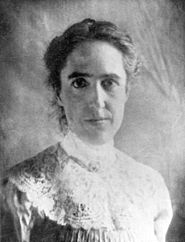Henrietta Swan Leavitt
Henrietta Swan Leavitt was an American astronomer who discovered the relation between the luminosity and the period of Cepheid variable stars. A graduate of Radcliffe College, Leavitt started working at the Harvard College Observatory as a computer in 1893, examining photographic plates in order to measure and catalog the brightness of stars. Though she received little recognition in her lifetime, it was her discovery that first allowed astronomers to measure the distance between the Earth and faraway galaxies. She explained her discovery A straight line can readily be drawn among each of the two series of points corresponding to maxima and minima, thus showing that there is a simple relation between the brightness of the variables and their periods. After Leavitts death, Edwin Hubble used the luminosityperiod relation for Cepheids together with spectral shifts first measured by fellow astronomer Vesto Slipher at Lowell Observatory to determine that the universe is expanding .
Henrietta Swan Leavitt, the daughter of Congregational church minister George Roswell Leavitt and his wife Henrietta Swan , was born in Lancaster, Massachusetts, a descendant of Deacon John Leavitt, an English Puritan tailor, who settled in the Massachusetts Bay Colony in the early seventeenth century. She attended Oberlin College, and graduated from Radcliffe College, then called the Society for the Collegiate Instruction for Women, with a bachelors degree in 1892. She studied a broad curriculum including classical Greek, fine arts, philosophy, analytic geometry and calculus. It wasnt until her fourth year of college that Leavitt took a course in astronomy, in which she earned an A.27 She then traveled in America and in Europe during which time she lost her hearing.
Source: Wikipedia

